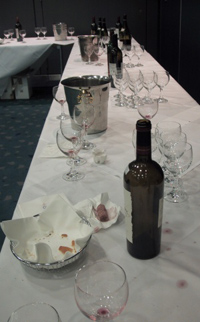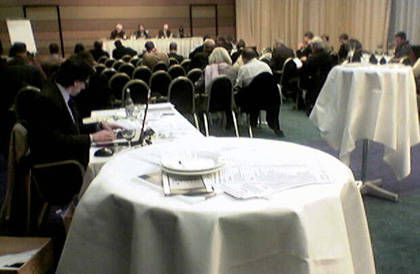At one of the last major auctions in Zurich, lot 899 caused a sensation. An empty bottle of Mouton Rothschild was offered. It went away, net at 63 , which makes a gross purchase price of 80. The bidder would have gone even higher, up to 130 net. This is just one of the many peculiarities and abstrusities of wine auctions. Logic and common value concepts are often set aside.

|
| At the auction table: f.l.t.r. assistant% auctioneer% notary |
But this is exactly what makes auctions so exciting. They are the stock exchanges of the wine business. Trends are emerging, developments are becoming apparent, speculations about the expected future are being made long before the wine lover and connoisseur can give an account of them.
For more than 5 years, I have been following the auction events: I have been eagerly noting down results and observations, I have been compiling lists and tables. Many of my wine friends know this and I am asked again and again how an international auction is going on.

|
| Before the auction you can test some highlights |
This calculation is made more difficult by the fact that the prices are always net prices. To this must be added - for the buyer - the buyer's premium (about 10% per lot), a fixed handling fee (about 8 ) and the sales tax. All this results in a gross price that is about 20% higher than the hammer price. But nobody talks about this during the auction. The careful bidder is therefore constantly calculating!
Also the handling differs considerably from auction to auction. While some start with a known, fixed minimum price, others only give lower and upper "estimated prices". The bidding is usually much lower than the lower estimated price.
The auction participants (most of them are men!) are divided into four categories. The most important customers are not present: they have bid "in writing", with an upper limit known only to the auctioneer. The crier represents this clientele.
In fact, there are usually written bids - some of them quite high - for more than two-thirds of the lot. If there are several for the same lot, the auctioneer starts one step above the second highest bid. Only then is it the auction room's turn.
Here, 20 and 100 interested parties have gathered, all "armed" with a number. This clientele is in the minority. If you observe them closely, they can be divided into three categories.
The dealers: they mainly buy valuable single bottles and cases: mostly in rows. For example, five lots of "Ausone", 1979, the lot at 1000 net. Or 30 magnum bottles of Margaux, 2001, the bottle at 430. Soon, the wine lover and connoisseur can get dizzy.
Another group is made up of collectors and wine lovers who are looking for specific bottles, specific vintages or specific wineries (brands). One quickly senses when one of them in the room "absolutely has to have" a very specific lot. Passions often prevail and reasonable calculations are overridden, prices skyrocket.

|
| Only a "conspiratorial" group takes part personally in auctions |
There are also the "bargain hunters". They don't let themselves be driven, they usually buy what dealers and collectors "leave lying around". These bidders can also be recognized quickly. They often wait until the auctioneer calls out "Dutch" one or the other time (although very rarely), i.e. in decreasing price steps, up to a minimum price (which one does not know) at which the lot "declines" or is purchased by bargain hunters (usually with laughter).
Finally, there are those who are curious: those who bid from time to time, but above all those who observe and analyse offers, trends and developments. They often hold out for five hours or more, until the very last lot, until there is hardly a dealer or collector left in the room.
After this description of an auction process, the question remains: Where is the actual "secret" for the fascination at wine auctions? What is to be experienced, to be read out, to be observed?
I will try to describe and interpret this in one of the next columns. Until then: A lot of courage (and self-control) who dares to go to one of the big international wine auctions for the first time. One can also leave them again without "loot"? Can you really?
Yours sincerely, Peter
(Züllig)